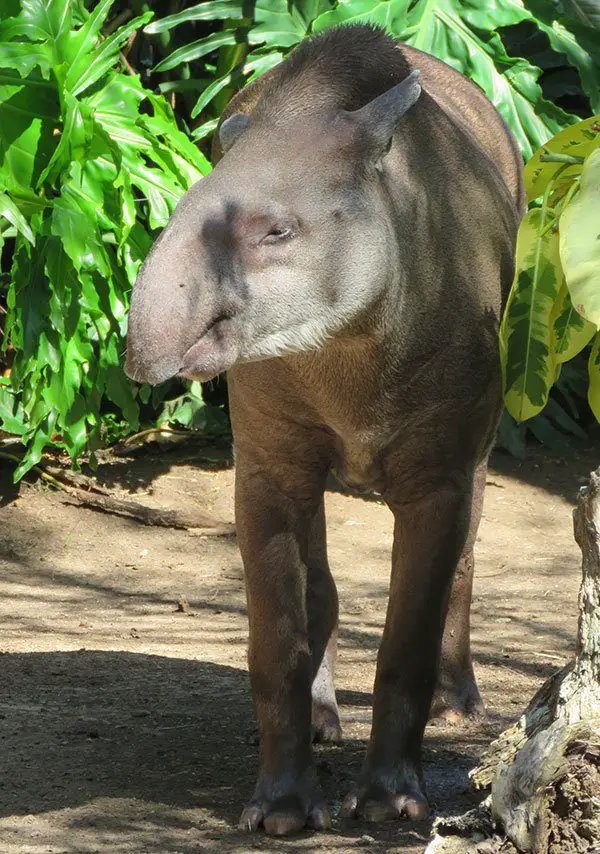
So, what exactly do Brazilian tapirs eat, and how do they hunt for their meals? Let’s dive in and explore their fascinating world. Understanding the Brazilian tapir’s eating habits can shed light on its role in the ecosystem and highlight its importance in maintaining the balance of the rainforest. It’s a story not just about what they eat but also about their survival strategies in the wild.
What Do Brazilian Tapirs Eat?
Brazilian tapirs are herbivores, which means they primarily eat plants. Imagine wandering through a rainforest filled with a variety of plants, trees, and shrubs. That’s the tapir’s buffet! They have a varied diet that includes a mix of leaves, fruits, and even aquatic plants.
Fruits and Leaves
One of their favorite foods is fruits—especially those that drop from trees. They’re particularly fond of berries and other small, sweet fruits. Tapirs use their long snouts, almost like flexible hands, to grab food from hard-to-reach places. Their flat molars make it easy for them to grind down leaves and tough vegetation.
Aquatic Plants
Interestingly, they don’t shy away from the water. Brazilian tapirs are known to wade into rivers and lakes to munch on aquatic plants. This behavior is not just about finding food; it also helps them stay cool in the hot climate. Imagine how refreshing it must feel to snack in the water on a warm day!
How Do Tapirs Forage for Food?
Foraging for food is more than just strolling around and munching on whatever they find. Brazilian tapirs are strategic about their eating habits. They often stick to certain trails in the forest, which they create over time by following the same paths.
Using Their Senses
Tapirs have an excellent sense of smell, which they rely on to detect ripe fruits or fresh leaves. When they spot a tasty snack, they use their strong limbs to push through underbrush and reach it. Their body is quite agile for such a large animal, allowing them to navigate the dense forest without much trouble.
Nocturnal Grazers
Another interesting aspect of their foraging is that Brazilian tapirs are typically nocturnal. They prefer to forage in the coolness of the evening when it’s quieter and safer from predators. You might picture a tapir quietly sneaking through the shadows, using its keen sense of hearing to stay alert to any dangers nearby.
Tapir Nutritional Needs
Just like us, Brazilian tapirs require a balanced diet to stay healthy. Their bodies need a mix of different nutrients, including carbohydrates, vitamins, and minerals. Eating a wide variety of plants helps ensure they get everything they need.
Fiber for Digestion
One of the critical components of their diet is fiber. Tapirs eat a lot of fibrous plant materials, which is essential for a healthy digestive system. They have a relatively simple stomach, so consuming high-fiber food helps maintain gut health and prevents issues that could arise from eating just one type of food.
Fruit and Water Content
Additionally, fruits provide tapirs with a good source of hydration and essential vitamins. On hot days, munching on juicy fruits helps them stay cool and refreshed. Staying hydrated is key, especially since they spend time in warmer areas of the rainforest.
Predators and the Tapir’s Defense Mechanisms
While tapirs are herbivores and primarily focused on finding food, they also have to be aware of their surroundings. They face threats from predators like jaguars and crocodiles. So how do Brazilian tapirs protect themselves when danger is near?
Using Their Size and Strength
First off, their size can be a deterrent. Brazilian tapirs can weigh up to 700 pounds, making them quite formidable. When threatened, they often rely on their size and strength to fight back instead of fleeing. If a predator gets too close, a tapir might charge at it, using its weight to defend itself.
Finding Shelter
Another strategy is their ability to find shelter. Tapirs are excellent swimmers and often use this skill to escape predators. They dive into the water, where they can hide or even swim to safety. You might imagine a tapir sinking below the water’s surface, just waiting for danger to pass.
The Role of Tapirs in the Ecosystem
Brazilian tapirs play a crucial role in their habitat. As they wander through the forest, they help shape the environment in significant ways.
Seed Dispersers
One of their most critical contributions is acting as seed dispersers. When tapirs eat fruits, they don’t digest all the seeds. Instead, these seeds pass through their system and are deposited in different locations when they poop. This process helps promote plant growth and biodiversity in the rainforest.
Food Source for Other Species
Additionally, the tapir can be a food source for larger carnivores, which is part of the natural cycle. Their presence helps maintain the balance of the ecosystem, ensuring that other species also thrive. So, the next time you think of the Brazilian tapir, remember it’s not just about what they eat but how they support life in their forest home.
Challenges Facing Brazilian Tapirs
Despite their importance in the ecosystem, Brazilian tapirs face several challenges today. Habitat loss and poaching are significant threats that impact their survival.
Deforestation
The expansion of agriculture and logging has led to significant habitat loss for tapirs. As forests are cleared, tapirs lose their homes and food sources. It’s like taking away a restaurant from a diner—it leaves them struggling to find a new place to eat.
Human Encroachment
Additionally, tapirs are often hunted for their meat or captured for the exotic pet trade. This practice has dramatically reduced their populations in some areas. Conservation efforts are crucial to protect these gentle giants and ensure that they remain a part of the rainforest ecosystem.
Conservation and Protection Efforts
Many organizations work to protect Brazilian tapirs and their habitats, focusing on conservation and education.
Protected Areas
Creating protected areas, like national parks, helps secure a safe environment for tapirs to thrive. These areas are crucial for preserving their natural habitats and providing a sanctuary away from human threats.
Community Involvement
Education also plays a role. Teaching local communities about the importance of tapirs and their role in the ecosystem helps foster a sense of responsibility toward preserving these creatures. Engaging communities in conservation efforts can lead to positive changes in how they interact with wildlife.
In conclusion, the Brazilian tapir is an often-overlooked but vital player in the ecosystem of the rainforest. Their diet, foraging strategies, and the challenges they face paint a complete picture of how these fascinating animals contribute to their habitats. By understanding and supporting conservation efforts, we can help ensure that tapirs continue to thrive in the wild for generations to come.

